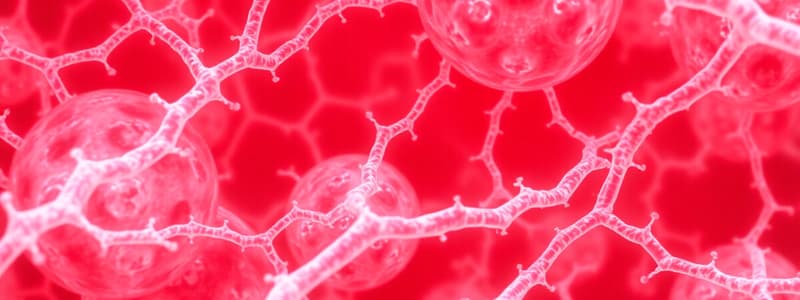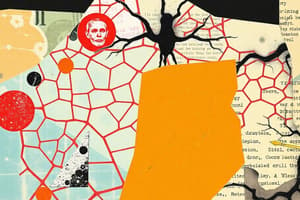Podcast
Questions and Answers
What is the characteristic appearance of the nucleus in plasma cells?
What is the characteristic appearance of the nucleus in plasma cells?
- Dense and oval
- Cartwheel appearance (correct)
- Compact and round
- Irregular and fragmented
What is the primary function of plasma cells?
What is the primary function of plasma cells?
- Secretion of heparin
- Production of platelets
- Humeral immunity via antibodies (correct)
- Regulation of blood pressure
Which of the following is a clinical implication of multiple myeloma?
Which of the following is a clinical implication of multiple myeloma?
- Increase in white blood cell count
- Overproduction of erythropoietin
- Suppression of hematopoiesis (correct)
- Increase in erythropoiesis
Mast cells secrete which of the following substances?
Mast cells secrete which of the following substances?
In histological structure, plasma cells are distinguished by which feature?
In histological structure, plasma cells are distinguished by which feature?
What type of connective tissue do mast cells primarily populate?
What type of connective tissue do mast cells primarily populate?
What effect does multiple myeloma have on bone health?
What effect does multiple myeloma have on bone health?
Which statement is true regarding the cytoplasm of mast cells?
Which statement is true regarding the cytoplasm of mast cells?
What is the primary component of reticular fibers?
What is the primary component of reticular fibers?
Which condition is linked to a deficiency of α1-antitrypsin?
Which condition is linked to a deficiency of α1-antitrypsin?
Which of the following is NOT a characteristic of ground substance?
Which of the following is NOT a characteristic of ground substance?
What is a common consequence of mutations in the fibrillin gene?
What is a common consequence of mutations in the fibrillin gene?
Which type of fiber is characterized as very thin and capable of branching to form networks?
Which type of fiber is characterized as very thin and capable of branching to form networks?
What type of syndrome is caused by a deficiency of a lysosomal enzyme that degrades dermatan sulfate and heparan sulfate?
What type of syndrome is caused by a deficiency of a lysosomal enzyme that degrades dermatan sulfate and heparan sulfate?
What compound is primarily responsible for carrying the structural integrity of elastic fibers?
What compound is primarily responsible for carrying the structural integrity of elastic fibers?
Which of the following diseases is characterized by a lack of resistance in tissues rich in elastic fibers?
Which of the following diseases is characterized by a lack of resistance in tissues rich in elastic fibers?
What is the primary function of plasma cells?
What is the primary function of plasma cells?
Which type of fibers is characterized by being yellow and elastic in nature?
Which type of fibers is characterized by being yellow and elastic in nature?
In which anatomical sites are mast cells primarily found?
In which anatomical sites are mast cells primarily found?
How are yellow elastic fibers distinguished in a histological stain?
How are yellow elastic fibers distinguished in a histological stain?
What role does mast cell secretion of heparin and histamine play in the body?
What role does mast cell secretion of heparin and histamine play in the body?
What is a characteristic feature of white collagenous fibers?
What is a characteristic feature of white collagenous fibers?
What type of connective tissue tumor is associated with plasma cells?
What type of connective tissue tumor is associated with plasma cells?
What differentiates reticular fibers from other connective tissue fibers?
What differentiates reticular fibers from other connective tissue fibers?
Flashcards are hidden until you start studying
Study Notes
Connective Tissue Cells
- Fibroblasts: synthesize all types of fibers and ground substances in connective tissue.
- Macrophages: phagocytic cells responsible for ingesting and digesting foreign materials and cellular debris.
- Mast cells: secrete heparin, an anticoagulant, and histamine, a mediator of allergic reactions.
- Plasma cells: responsible for synthesizing antibodies, crucial for humoral immunity.
Connective Tissue Fibers
- Collagen fibers: most abundant and strongest type of connective tissue fibers, resist longitudinal stress.
- Appearance: white in color, form wavy bundles that branch, but individual fibers do not.
- Composition: composed of fibrils formed from type-I tropocollagen molecules.
- Staining: acidophilic with hematoxylin and eosin (H&E), blue with Mallory trichrome stain.
- Elastic fibers: provide elasticity to connective tissues.
- Appearance: yellow in color, branch and form elastic membranes.
- Composition: composed of an amorphous protein, elastin, surrounded by microfibrils called oxytalan fibers.
- Staining: acidophilic with H&E, yellow with Van-Gieson stain.
- Reticular fibers: form a delicate network that supports parenchymatous organs.
- Appearance: thin fibers that branch and anastomose.
- Staining: not stained with H&E, stained brown to black with silver.
- Composition: composed of type-III collagen coated by glycoprotein.
Ground Substance
- Composition: complex mixture of glycosaminoglycans (GAGs) and glycoproteins.
- Components:
- Proteoglycans: consist of proteins and repeating disaccharide units (e.g., hyaluronic acid, chondroitin sulfate, dermatan sulfate, keratan sulfate, and heparan sulfate).
- Glycoproteins: conjugation of proteins and carbohydrates (e.g., chondronectin, fibronectin, integrins, and laminin).
- Water and salts.
Plasma cells
- Origin: B lymphocytes.
- Appearance: ovoid in shape, small eccentric nucleus with heterochromatin radiating outwards (cartwheel appearance), basophilic cytoplasm with a pale area representing the Golgi apparatus (negative Golgi image).
- Functions:
- Responsible for humoral immunity (Antibodies).
- Present in the submucosa of the gastrointestinal tract.
Mast Cells
- Appearance: oval or rounded, abundant in loose connective tissue along blood vessels, central rounded nucleus, cytoplasm full of basophilic secretory granules.
- Functions:
- Secrete heparin, an anticoagulant, and a cofactor for lipoprotein lipase.
- Secrete histamine, involved in antigen-antibody reactions and allergies.
Studying That Suits You
Use AI to generate personalized quizzes and flashcards to suit your learning preferences.



